|
|
|

|
|
2013 (vol. 13)
|
|
Letter 7 [2013]: Dissocladella hauteriviana
MASSE in MASSE et al., 1999 (non MASSE, 1976), another lower
Urgonian Dasycladalean alga revisited, by Bruno GRANIER.-
Format [HTML] or [PDF
1,990 KB]
Reference: [CG2013_L07]
DOI: 10.4267/2042/53035
Lang.:
|
|
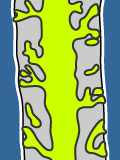 Abstract:
First ascribed to the Triploporellacean genus Dissocladella (Pia
in Rao & Pia,
1936), the species D. hauteriviana Masse in
Masse et al., 1999, was supposedly
characterized by a thallus bearing whorls of laterals each consisting of a
stumpy primary with a tuft of four slim secondaries at its top. A restudy of the
laterals proves that they split, not only once, but several times, and
stepwisely decrease in diameter. The species is re-ascribed to the Family
Thyrsoporellaceae in a new combination to the genus Deloffrella Granier
& Michaud, 1987. Its known stratigraphic range
is rather short (Late Valanginian-earliest Barremian). In addition, it
disappears earlier than its companion Polyphysacean alga, i.e., Clypeina
paucicalcarea (Conrad, 1970), and its
geographical distribution is broader, which makes it a good index fossil for
lower Urgonian carbonate platform series. Abstract:
First ascribed to the Triploporellacean genus Dissocladella (Pia
in Rao & Pia,
1936), the species D. hauteriviana Masse in
Masse et al., 1999, was supposedly
characterized by a thallus bearing whorls of laterals each consisting of a
stumpy primary with a tuft of four slim secondaries at its top. A restudy of the
laterals proves that they split, not only once, but several times, and
stepwisely decrease in diameter. The species is re-ascribed to the Family
Thyrsoporellaceae in a new combination to the genus Deloffrella Granier
& Michaud, 1987. Its known stratigraphic range
is rather short (Late Valanginian-earliest Barremian). In addition, it
disappears earlier than its companion Polyphysacean alga, i.e., Clypeina
paucicalcarea (Conrad, 1970), and its
geographical distribution is broader, which makes it a good index fossil for
lower Urgonian carbonate platform series.
|
|
Online since December 25, 2013
|
|
Article 9 [2013]: Silurian cornulitids of Estonia (Baltica), by Olev VINN & Mark A. WILSON.-
Format [HTML] or [PDF
1,050 KB]
Reference: [CG2013_A09]
DOI: 10.4267/2042/53034
Lang.:
|
|
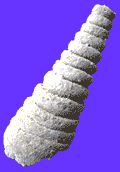 Abstract: Seven species of cornulitids are systematically described from the Silurian of Saaremaa and Hiiumaa islands, Estonia. There are three species of cornulitids in the Rhuddanian, three in the Sheinwoodian, single species in the Gorstian and Ludfordian, and three species in the Pridoli. Cornulitids have a facies range from pelletal limestones of shoal environments to deeper ramp marls. Endobiotic cornulitid symbionts occur in stromatoporoids found in shoal and open shelf zones. Gregarious aggregates are restricted to the limestones of the open shelf zone possibly because of higher nutrient levels in open shelf zone waters as compared to those of the deeper ramp. Unattached free forms are especially common in offshore deeper ramp marls presumably due to their adaption to life on a soft bottom. Solitary attached forms occur in all facies zones where cornulitids are present. Because the life modes of cornulitids are closely associated with particular facies zones, they are useful tools for paleoecological
reconstructions. Abstract: Seven species of cornulitids are systematically described from the Silurian of Saaremaa and Hiiumaa islands, Estonia. There are three species of cornulitids in the Rhuddanian, three in the Sheinwoodian, single species in the Gorstian and Ludfordian, and three species in the Pridoli. Cornulitids have a facies range from pelletal limestones of shoal environments to deeper ramp marls. Endobiotic cornulitid symbionts occur in stromatoporoids found in shoal and open shelf zones. Gregarious aggregates are restricted to the limestones of the open shelf zone possibly because of higher nutrient levels in open shelf zone waters as compared to those of the deeper ramp. Unattached free forms are especially common in offshore deeper ramp marls presumably due to their adaption to life on a soft bottom. Solitary attached forms occur in all facies zones where cornulitids are present. Because the life modes of cornulitids are closely associated with particular facies zones, they are useful tools for paleoecological
reconstructions.
|
|
Online since December 25, 2013
|
|
Obituary notice: Jean-Paul COLIN.-
Format [HTML] or [PDF
245 KB]
Reference: [Jean-Paul_Colin]
DOI:
10.4267/2042/51849
Lang.:
|
|
 Jean-Paul COLIN
(1948 - 2013) passed away at the end of this summer and his departure is a
cruel loss for our community, not only as a scientist of international repute,
but also as an outstanding organizer and, for a number of us, as a good friend. Jean-Paul COLIN
(1948 - 2013) passed away at the end of this summer and his departure is a
cruel loss for our community, not only as a scientist of international repute,
but also as an outstanding organizer and, for a number of us, as a good friend.
Following his PhD degree in micropaleontology from the University of Paris VI in
1973, he spent his entire career in the exploration branch of the oil industry,
first with EXXON in Houston and Bègles from 1974 to 1989, and then with
ESSO
REP in Bègles from 1989 to 2000. (...)
Jean-Paul COLIN was a great field and laboratory naturalist and as a scientific
partner was always open to often lively discussion. His enthusiasm for the
ostracods was huge and it was a pleasure to discuss with him. (...)
Being a very friendly
person, he helped ostracodologists worldwide who went to him with questions,
particularly the young.
Besides these activities, Jean-Paul COLIN was member of the editorial board
of several international journals. (...) He was Associate Editor of Carnets de
Géologie [Notebooks on Geology].
|
|
Online since November 22, 2013
|
|
Addendum: In order to be complete the bibliographic list of Jean-Paul Colin should also have included the following missing reference (Fida Medina,
personal communication): Medina F., Vachard D., Colin J.-P.,
Ouarhache D. & Ahmamou M'F. (2001).- Charophytes et ostracodes du niveau
carbonate de Taourirt Imzilen (Membre d'Aglegal, Trias d'Argana) : implications
stratigraphiques.- Bulletin de l'Institut scientifique, Rabat, (section Sciences
de la Terre), no. 23, p. 21-26.
|
|
Format [HTML]
or [PDF
17 KB]
Online since February 28, 2014
|
|
Letter 6 [2013]: About the generic attribution of Megatyloceras casei HUMPHREY, 1949 (Ammonoidea, Ancyloceratina), from the Aptian of Mexico, by Josep A. MORENO-BEDMAR & Gérard DELANOY.-
Format [HTML] or [PDF
2,824 KB]
Reference: [CG2013_L06]
DOI: 10.4267/2042/51826
Lang.:
|
|
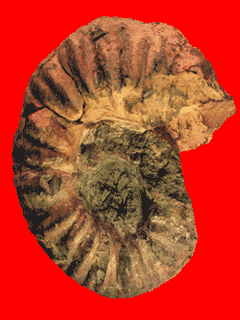 Abstract:
In the present work we review the generic attribution of the Mexican ammonoid species Megatyloceras casei Humphrey,
1949, through a careful examination of the holotype housed in the University of Michigan and with reference to new biostratigraphic data from the type locality. We assign
here this species to the subfamily Cheloniceratinae and to the genus Epicheloniceras Casey,
1954. Abstract:
In the present work we review the generic attribution of the Mexican ammonoid species Megatyloceras casei Humphrey,
1949, through a careful examination of the holotype housed in the University of Michigan and with reference to new biostratigraphic data from the type locality. We assign
here this species to the subfamily Cheloniceratinae and to the genus Epicheloniceras Casey,
1954.
|
|
Online since November 11, 2013
|
|
Article 8 [2013]: Daniel ŒHLERT (1849-1920): scientific biography and bibliography,
by Christian C. EMIG.-
Format [HTML] or [PDF
455 KB]
Reference: [CG2013_A08]
DOI: 10.4267/2042/51825
Lang.:
|
|
 Abstract: Daniel Œhlert (1849-1920): scientific biography and bibliography.- Daniel Œhlert (1849-1920) spent his entire career in Laval (Mayenne, France). His duties as a librarian of the city of Laval, then as curator of the museums of archaeology and natural history of Laval, allowed him freedom to focus on palaeontology and geology. He worked with his wife Pauline both in the field in the
departments of Mayenne and Sarthe. In between field trips in the Mayenne and Sarthe, they shared the
research during their long stays in Paris, working at the Sorbonne. Œhlert's studies focused mainly on faunas of
the Palaeozoic seas of Maine, Anjou and Cotentin. Œhlert devoted
himself primarily on describing crinoids, trilobites and brachiopods. In his collection, located in the "Musée des Sciences"
(Laval, Mayenne, France), more than 20 new genera with more than 150 new invertebrate species have been described. His geological and stratigraphical work is largely original, involving almost exclusively Palaeozoic areas in the departments of Mayenne and Sarthe, and secondarily in the departments of Orne and Ille-et-Vilaine. In 1884, he took a position at the "Service de la Carte géologique de France". More
than a hundred publications spread out from 1877 ended abruptly in 1911 with the death of his wife Pauline. A list of all his works is provided. Abstract: Daniel Œhlert (1849-1920): scientific biography and bibliography.- Daniel Œhlert (1849-1920) spent his entire career in Laval (Mayenne, France). His duties as a librarian of the city of Laval, then as curator of the museums of archaeology and natural history of Laval, allowed him freedom to focus on palaeontology and geology. He worked with his wife Pauline both in the field in the
departments of Mayenne and Sarthe. In between field trips in the Mayenne and Sarthe, they shared the
research during their long stays in Paris, working at the Sorbonne. Œhlert's studies focused mainly on faunas of
the Palaeozoic seas of Maine, Anjou and Cotentin. Œhlert devoted
himself primarily on describing crinoids, trilobites and brachiopods. In his collection, located in the "Musée des Sciences"
(Laval, Mayenne, France), more than 20 new genera with more than 150 new invertebrate species have been described. His geological and stratigraphical work is largely original, involving almost exclusively Palaeozoic areas in the departments of Mayenne and Sarthe, and secondarily in the departments of Orne and Ille-et-Vilaine. In 1884, he took a position at the "Service de la Carte géologique de France". More
than a hundred publications spread out from 1877 ended abruptly in 1911 with the death of his wife Pauline. A list of all his works is provided.
|
|
Online since November 11, 2013
|
|
Article 7 [2013]: Revision of the Jesse Harlan JOHNSON Collection. Part 1. Some fossil Dasycladales from Guatemala,
by Bruno GRANIER, Rajka RADOIČIĆ & Katica DROBNE.-
Format [HTML] or [PDF
7,459 KB]
Reference: [CG2013_A07]
DOI: 10.4267/2042/51824
Lang.:
|
|
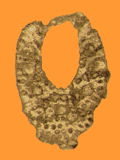 Abstract: This first report is a revision of fossil calcareous green algae
(Dasycladales) described from the Upper
Cretaceous and Paleocene series of Guatemala. Among other things in their 1965
paper J.H. Johnson and H.V. Kaska introduced three new species originally referred to the genera Acroporella, Cylindroporella, and Cymopolia.
One species, which has previously been referred to the genus Cylindroporella, is a foraminifer. Abstract: This first report is a revision of fossil calcareous green algae
(Dasycladales) described from the Upper
Cretaceous and Paleocene series of Guatemala. Among other things in their 1965
paper J.H. Johnson and H.V. Kaska introduced three new species originally referred to the genera Acroporella, Cylindroporella, and Cymopolia.
One species, which has previously been referred to the genus Cylindroporella, is a foraminifer.
|
|
Supplementary material: Color
plates [PDF
1,368 KB]
|
|
Online since November 11, 2013
|
|
Letter 5 [2013]: Paleotropical pollen grains from the Neuquén Group, Patagonia, Argentina, by
Patricia VALLATI.-
Format [HTML] or [PDF
297 KB]
Reference: [CG2013_L05]
DOI: 10.4267/2042/51218
Lang.:
|
|
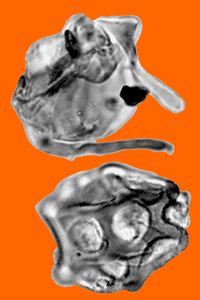 Abstract: This paper discusses the presence of elater-bearing pollen grains and other characteristic paleotropical palynomorphs in the mid to Late Cretaceous Neuquén Group at the El Zampal locality, south of Mendoza Province, Argentina. Abstract: This paper discusses the presence of elater-bearing pollen grains and other characteristic paleotropical palynomorphs in the mid to Late Cretaceous Neuquén Group at the El Zampal locality, south of Mendoza Province, Argentina.
The elaterates characterize the equatorial paleofloristic province in the Albian-Cenomanian. The species Elateroplicites africaensis is present in the pollen assemblage recovered from the lower section of the Huincul Formation, a basal unit of the studied Neuquén Group. It represents the first record of elater-bearing pollen grains in Argentina and marks their southernmost extension. Other conspicuous paleotropical elements recorded in different lithostratigraphic units of the Neuquén Group include gymnospermous polyplicate pollen grains and angiosperm pollen, including two species of the periporate pollen genus Cretacaeiporites and the triporate pollen species Confossia vulgaris. The paleobiogeographic and biostratigraphic significance of the paleotropical sporomorph record in the Cretaceous palynofloras of the Neuquén Group at El Zampal is herein discussed.
|
|
Online since August 2, 2013
|
|
Letter 4 [2013]: Praeorbitolina claveli
n.sp. (benthic Foraminifera) from the Lower Aptian sensu lato (Bedoulian) of Central Iran, by Felix SCHLAGINTWEIT, Ioan I. BUCUR, Koorosh RASHIDI & Behnam SABERZADEH.-
Format [HTML] or [PDF
1,755 KB]
Reference: [CG2013_L04]
DOI: 10.4267/2042/51217
Lang.:
|
|
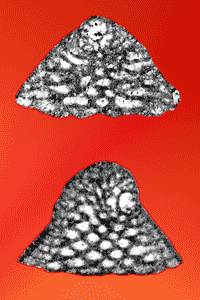 Abstract: The new orbitolinid foraminifer, Praeorbitolina claveli
n.sp., is described
from the Lower Aptian (Bedoulian) of Central Iran. It is characterized by an eccentric
embryonic apparatus displaying both a subdivided subembryonic zone and a
deuteroconch. The Barremian-Aptian orbitolinid association of this area has a typical
northern Tethyan character (e.g., "association à Valserina"
of Cherchi and Schroeder,
1973). Abstract: The new orbitolinid foraminifer, Praeorbitolina claveli
n.sp., is described
from the Lower Aptian (Bedoulian) of Central Iran. It is characterized by an eccentric
embryonic apparatus displaying both a subdivided subembryonic zone and a
deuteroconch. The Barremian-Aptian orbitolinid association of this area has a typical
northern Tethyan character (e.g., "association à Valserina"
of Cherchi and Schroeder,
1973).
|
|
Online since August 2, 2013
|
|
Article 6 [2013]: New data on the Valanginian - Hauterivian Ammonites from the stratotypical area of Neuchâtel (Swiss Jura Mountains) : biostratigraphic
implications,
by Pierre-Olivier MOJON, Antonio MUSOLINO, Stefan BUCHER & Bernard CLAUDE.-
Format [HTML] or [PDF
1,254 KB]
Reference: [CG2013_A06]
DOI: 10.4267/2042/51216
Lang.:
|
|
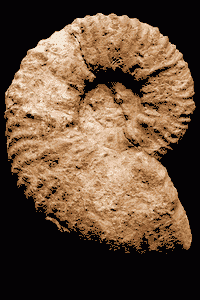 Abstract: New collections of Upper Valanginian - Lower Hauterivian ammonites yield precisions about the biostratigraphical scheme of the Lower Cretaceous in the stratotypical area of Neuchâtel (Swiss Jura Mountains). Thus, Stoicoceras pitrei (Busnardo,
1966) from the "Calcaire roux limoniteux" is reported
in the upper Saynoceras verrucosum Biozone (Karakaschiceras pronecostatum Subzone) of the Upper Valanginian. In the Lower Hauterivian, Olcostephanus (O.) variegatus Paquier, 1900, from the upper part of the "Marnes bleues d'Hauterive" and Saynella cf. clypeiformis (d'Orbigny,
1841) from the "Marnes d'Uttins" (top of the lower part of the "Pierre jaune de Neuchâtel") extend
greatly the range of the Lyticoceras nodosoplicatum Biozone compared to a more reduced Crioceratites loryi Biozone indicated by Saynella neocomiensis (Baumberger, 1905) and
a unique specimen of Crioceratites cf. gr. loryi (Sarkar,
1955) found in 1907. Abstract: New collections of Upper Valanginian - Lower Hauterivian ammonites yield precisions about the biostratigraphical scheme of the Lower Cretaceous in the stratotypical area of Neuchâtel (Swiss Jura Mountains). Thus, Stoicoceras pitrei (Busnardo,
1966) from the "Calcaire roux limoniteux" is reported
in the upper Saynoceras verrucosum Biozone (Karakaschiceras pronecostatum Subzone) of the Upper Valanginian. In the Lower Hauterivian, Olcostephanus (O.) variegatus Paquier, 1900, from the upper part of the "Marnes bleues d'Hauterive" and Saynella cf. clypeiformis (d'Orbigny,
1841) from the "Marnes d'Uttins" (top of the lower part of the "Pierre jaune de Neuchâtel") extend
greatly the range of the Lyticoceras nodosoplicatum Biozone compared to a more reduced Crioceratites loryi Biozone indicated by Saynella neocomiensis (Baumberger, 1905) and
a unique specimen of Crioceratites cf. gr. loryi (Sarkar,
1955) found in 1907.
|
|
Online since August 2, 2013
|
|
Article 5 [2013]: Study of the species Ochetoceras (Ochetoceras)
canaliculatum (de Buch, 1831) (Middle Oxfordian, Transversarium Zone), by
Philippe QUEREILHAC.-
Format [HTML] or [PDF
4,465 KB]
Reference: [CG2013_A05]
DOI: 10.4267/2042/51215
Lang.:
|
|
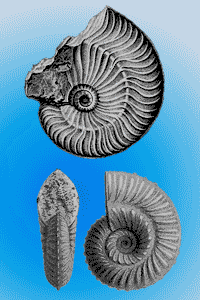 Abstract:
The species Ochetoceras (Ochetoceras) canaliculatum (de Buch, 1830
[1831]), discussed here, is certainly the most representative of the
Transversarium Zone (Middle
Oxfordian) in the Tethyian domain (Mediterranean Province). It appears in the Parandieri Subzone and seems to
go extinct in the Stenocycloides Subzone (Late
Oxfordian, base of the Bifurcatus Zone). It is abundantly represented in the ammonite populations and has a wide geographical range
and has a wide geographical spread. Analysis shows that it
is always associated with species referred to Ochetoceras (Ochetoceras) hispidum [M] (Oppel, 1863) and Glochiceras (Glochiceras) subclausum [m] (Oppel, 1863) ;
many authors have long thought that it was a single
species. These three "species" are thus here united under the name Ochetoceras (Ochetoceras) canaliculatum (de Buch,
1831): macroconchs corresponding to the "morphs"
canaliculatum and hispidum are polymorphic evolving from a
narrow to a wide whorl cross section whereas the "morph"
subclausum is a sexual dimorphic microconch. Abstract:
The species Ochetoceras (Ochetoceras) canaliculatum (de Buch, 1830
[1831]), discussed here, is certainly the most representative of the
Transversarium Zone (Middle
Oxfordian) in the Tethyian domain (Mediterranean Province). It appears in the Parandieri Subzone and seems to
go extinct in the Stenocycloides Subzone (Late
Oxfordian, base of the Bifurcatus Zone). It is abundantly represented in the ammonite populations and has a wide geographical range
and has a wide geographical spread. Analysis shows that it
is always associated with species referred to Ochetoceras (Ochetoceras) hispidum [M] (Oppel, 1863) and Glochiceras (Glochiceras) subclausum [m] (Oppel, 1863) ;
many authors have long thought that it was a single
species. These three "species" are thus here united under the name Ochetoceras (Ochetoceras) canaliculatum (de Buch,
1831): macroconchs corresponding to the "morphs"
canaliculatum and hispidum are polymorphic evolving from a
narrow to a wide whorl cross section whereas the "morph"
subclausum is a sexual dimorphic microconch.
|
|
Online since August 2, 2013
|
|
Erratum: On page 219, one should read:
"À la lecture d'anciennes publications, il est apparu que le nom d'auteur (de Buch) avait été mal transcrit. L'Ammonites canaliculatus Graf von Münster,
de Buch, 1831, l'Ammonites hispidus Oppel,
1863,
et l'Ammonites subclausus Oppel, 1863, sont maintenant réunies sous l'appellation Ochetoceras (Ochetoceras) canaliculatum (de Buch,
1831)",
instead of:
"À la lecture d'anciennes publications, il est apparu que le nom d'auteur (de Buch) avait été mal transcrit et que la date de création de l'espèce (1831) était erronée : ces faits
ont été mis en évidence à l'aide de l'I.C.Z.N. (4ème édition,
1999), inconnu à l'époque. L'application des articles de ce dernier a permis de corriger ces erreurs. L'Ammonites canaliculatus Graf von Münster
-- figurée dans la publication de von Zieten datée de
1832 --, l'Ammonites hispidus Oppel, 1863 et l'Ammonites subclausus Oppel,
1863
-- toutes deux figurées et décrites par cet auteur --, sont maintenant réunies sous l'appellation Ochetoceras (Ochetoceras) canaliculatum (de Buch,
1831)".
|
|
Format [HTML]
or [PDF
30 KB]
Online since August 4, 2013
|
|
Letter 3 [2013]: Cornulitid tubeworms from the Ordovician of eastern Baltic, by Olev VINN.-
Format [HTML] or [PDF
635 KB]
Reference: [CG2013_L03]
DOI: 10.4267/2042/51214
Lang.:
|
|
 Abstract: Nine species of cornulitids are systematically described here from the Ordovician of Estonia. The earliest species,
Cornulites semiapertus, appears in the late Darriwilian (Middle Ordovician), the next two species appear in the Sandbian and there are a further six new species in the Katian, which indicates a rapid diversification of cornulitids in the Late Ordovician of Baltica. All the studied cornulitids from the Ordovician of Estonia occur in relatively shallow-water normal-marine sediments of a carbonate platform. The cornulitids are found encrusting mostly brachiopod shells (both syn vivo and post mortem). Abstract: Nine species of cornulitids are systematically described here from the Ordovician of Estonia. The earliest species,
Cornulites semiapertus, appears in the late Darriwilian (Middle Ordovician), the next two species appear in the Sandbian and there are a further six new species in the Katian, which indicates a rapid diversification of cornulitids in the Late Ordovician of Baltica. All the studied cornulitids from the Ordovician of Estonia occur in relatively shallow-water normal-marine sediments of a carbonate platform. The cornulitids are found encrusting mostly brachiopod shells (both syn vivo and post mortem).
|
|
Online since July 22, 2013
|
|
Article 4 [2013]: L'Estellon (Baronnies, France), a "Rosetta Stone" for the Urgonian biostratigraphy,
by Bruno GRANIER, Bernard CLAVEL, Michel MOULLADE, Robert BUSNARDO, Jean CHAROLLAIS, Guy TRONCHETTI & Pierre DESJACQUES.-
Format [HTML] or [PDF
8,169 KB]
Reference: [CG2013_A04]
DOI: 10.4267/2042/51213
Lang.:
|
|
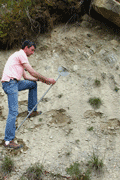 Abstract: Shallow-water assemblages of transported (freshly reworked) bioclasts (mainly orbitolinids and dasycladales) are observed in the deeper facies of the
"Vocontian Trough" (SE France). There these benthic assemblages can be directly correlated with ammonite zones. These new finds give an Early Barremian age to the earliest record of
Palorbitolina lenticularis as well as those of four so-called typical Early Aptian representatives of the genus
Orbitolinopsis. Actually most orbitolinid species recorded from the Late Barremian interval are now found present in Lower Barremian strata at L'Estellon. Some currently used correlation schemes for the Urgonian platforms, that are based on partial stratigraphic distribution ranges for the orbitolinids, --and consequently derived conclusions and hypotheses-- require at least in-depth revisions when they are not definitively refuted. Abstract: Shallow-water assemblages of transported (freshly reworked) bioclasts (mainly orbitolinids and dasycladales) are observed in the deeper facies of the
"Vocontian Trough" (SE France). There these benthic assemblages can be directly correlated with ammonite zones. These new finds give an Early Barremian age to the earliest record of
Palorbitolina lenticularis as well as those of four so-called typical Early Aptian representatives of the genus
Orbitolinopsis. Actually most orbitolinid species recorded from the Late Barremian interval are now found present in Lower Barremian strata at L'Estellon. Some currently used correlation schemes for the Urgonian platforms, that are based on partial stratigraphic distribution ranges for the orbitolinids, --and consequently derived conclusions and hypotheses-- require at least in-depth revisions when they are not definitively refuted.
|
|
Online since July 22, 2013
|
|
Erratum: On page 175, first column
(bottom), one should read: "2) Genus Dictyoconus Blanckenhorn,
1900", instead of: "2) Genus Dictyorbitolina Blanckenhorn,
1900".
On page 175, second column (top), one should read: "Provisionally attributed to the genus Dictyoconus", instead of: " Provisionally attributed to the genus Dictyorbitolina".
On page 179, second column, one should read: "nor between Dictyoconus ? vercorii and Dictyoconus
aff. vercorii", instead of: "nor between Dictyorbitolina ? vercorii and Dictyorbitolina aff. Vercorii".
Similarly, on Plate 8, figs. 10-12, Plate 9, fig. 7, and Plate 10, fig. 4, one should read "Dictyoconus ? vercorii" instead of "Dictyorbitolina ? vercorii".
|
|
Format [HTML]
or [PDF
27 KB]
Online since December 25, 2013
|
|
Article 3 [2013]: Barremian ammonite fauna from L'Estellon section (Baronnies, SE France): preliminary biostratigraphic results, by
Robert BUSNARDO, Bruno GRANIER, Bernard CLAVEL & Jean CHAROLLAIS.-
Format [HTML] or [PDF
4,565 KB]
Reference: [CG2013_A03]
DOI: 10.4267/2042/51212
Lang.:
|
|
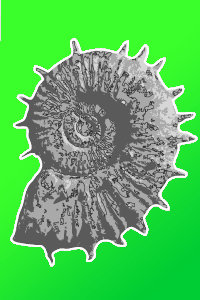 Abstract:
The study of the ammonite fauna in the L'Estellon section (Drôme department, SE France) allows us to date episodes with gravitational deposition in this area
of the "Vocontian Trough". They span most of the Barremian Stage, from the Nicklesi Zone up to the Giraudi Zone. We did not identify any Bedoulian redeposits,
the "Bedoulian ridge" auct. being latest Barremian in age. Abstract:
The study of the ammonite fauna in the L'Estellon section (Drôme department, SE France) allows us to date episodes with gravitational deposition in this area
of the "Vocontian Trough". They span most of the Barremian Stage, from the Nicklesi Zone up to the Giraudi Zone. We did not identify any Bedoulian redeposits,
the "Bedoulian ridge" auct. being latest Barremian in age.
|
|
Online since July 22, 2013
|
|
Memoir
2 [2013]: Priabonian mammals and reptiles from the Platé Massif
(Savoy, France), by Michel DELAMETTE & Jean A. REMY.-
Format [HTML]
or [PDF
5,875 KB]
Reference: [CG2013_M02]
DOI: 10.4267/2042/50056
Lang.:
|
|
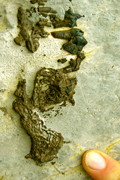 Abstract: A lens of marly limestone at the bottom of the Tertiary series of the Grandes
Platières (Platé Massif, Savoy) has yielded the most important collection
of fossil vertebrates so far known from the Paleogene of Western Alps. Ungulate
mammals are represented by 35 teeth to be referred to 9 taxa (4 perissodactyls and 5
artiodactyls). This new fauna appears contemporaneous with that of
La Débruge (MP 18 level), dated at about 35.5 My old. The new locality, called "gisement des Perdrix", is stratigraphically located 20-35 m underneath the other one in which Weidmann
et al. (1991) had found mammals to be attributed to the MP 20 level. So the new fauna is about 1.5 My older
than this latter. Its faunal composition and the swampy nature of the
deposit suggest that the occurring mammals were living in variegated surroundings, with woody
areas close to wet marshy ones. Abstract: A lens of marly limestone at the bottom of the Tertiary series of the Grandes
Platières (Platé Massif, Savoy) has yielded the most important collection
of fossil vertebrates so far known from the Paleogene of Western Alps. Ungulate
mammals are represented by 35 teeth to be referred to 9 taxa (4 perissodactyls and 5
artiodactyls). This new fauna appears contemporaneous with that of
La Débruge (MP 18 level), dated at about 35.5 My old. The new locality, called "gisement des Perdrix", is stratigraphically located 20-35 m underneath the other one in which Weidmann
et al. (1991) had found mammals to be attributed to the MP 20 level. So the new fauna is about 1.5 My older
than this latter. Its faunal composition and the swampy nature of the
deposit suggest that the occurring mammals were living in variegated surroundings, with woody
areas close to wet marshy ones.
|
|
Online since May 17, 2013
|
|
Letter 2 [2013]: An event bed with abundant Skolithos burrows from the late Pridoli (Silurian) of Saaremaa (Estonia), by Olev VINN & Mark A. WILSON.-
Format [HTML] or [PDF
1,833 KB]
Reference: [CG2013_L02]
DOI:
10.4267/2042/49316
Lang.:
|
|
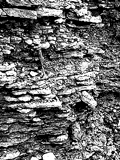 Abstract: Abundant Skolithos burrows are here described from a possible regressive event bed at Ohesaare cliff (Pridoli), Saaremaa, Estonia. The vertical, cylindrical burrows are identified as Skolithos rather than Trypanites because they intercept and bypass rather than cut bioclasts in the limestone matrix. The absence of encrustation on the upper bedding surface also is evidence that these traces are soft-sediment burrows rather than hardground borings. We interpret this intensive bioturbation by Skolithos-producing organisms as an indicator of a shallow water paleoenvironment with high hydrodynamic energy. Abstract: Abundant Skolithos burrows are here described from a possible regressive event bed at Ohesaare cliff (Pridoli), Saaremaa, Estonia. The vertical, cylindrical burrows are identified as Skolithos rather than Trypanites because they intercept and bypass rather than cut bioclasts in the limestone matrix. The absence of encrustation on the upper bedding surface also is evidence that these traces are soft-sediment burrows rather than hardground borings. We interpret this intensive bioturbation by Skolithos-producing organisms as an indicator of a shallow water paleoenvironment with high hydrodynamic energy.
|
|
Online since April 24, 2013
|
|
Article 2 [2013]: Xerticeras gen. nov., a new genus of micromorphic heteromorph ammonite (Ancyloceratina, Ancyloceratidae) from the lower Aptian of Spain,
by Gérard DELANOY, Josep A. MORENO-BEDMAR, José J. RUIZ & Domingo TOLÓS LLÁDSER.-
Format [HTML] or [PDF
4,285 KB]
Reference: [CG2013_A02]
DOI:
10.4267/2042/49315
Lang.:
|
|
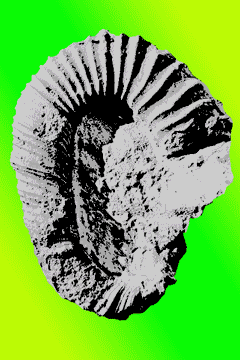 Abstract: Biostratigraphical and paleontological studies of lower
Aptian material from the Eastern Iberian Chain (Spain) have revealed the
presence of a new genus of micromorphic heteromorph ammonite: Xerticeras
gen. nov. (type species: Xerticeras salasi
sp. nov.). This new taxon comes from the Deshayesites
deshayesi and Dufrenoya furcata
ammonite zones. The size difference observed in the
population is considered due to sexual dimorphism. Abstract: Biostratigraphical and paleontological studies of lower
Aptian material from the Eastern Iberian Chain (Spain) have revealed the
presence of a new genus of micromorphic heteromorph ammonite: Xerticeras
gen. nov. (type species: Xerticeras salasi
sp. nov.). This new taxon comes from the Deshayesites
deshayesi and Dufrenoya furcata
ammonite zones. The size difference observed in the
population is considered due to sexual dimorphism.
|
|
Online since April 24, 2013
|
|
Letter 1 [2013]: Heteroporella ? paucicalcarea (Conrad, 1970), an Urgonian Dasycladalean alga revisited, by Bruno GRANIER.-
Format [HTML] or [PDF
1,412 KB]
Reference: [CG2013_L01]
DOI:
10.4267/2042/48737
Lang.:
|
|
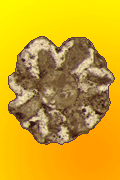 Abstract: When the species Heteroporella ? paucicalcarea (Conrad,
1970) was erected it was left in open nomenclature. Later on new combinations
were introduced but did not meet a general agreement among paleophycologists.
Considering the current acception of the Dasycladalean families, we ascribe it
to the Family Polyphysaceae and subsequently to the genus Clypeina (Michelin,
1845). Its known stratigraphic range is rather brief (Late Hauterivian-Early
Barremian), which makes it a good index fossil in Urgonian carbonate platform
series. Its geographical distribution is apparently restricted to Western
Europe (France, Spain and Switzerland). Abstract: When the species Heteroporella ? paucicalcarea (Conrad,
1970) was erected it was left in open nomenclature. Later on new combinations
were introduced but did not meet a general agreement among paleophycologists.
Considering the current acception of the Dasycladalean families, we ascribe it
to the Family Polyphysaceae and subsequently to the genus Clypeina (Michelin,
1845). Its known stratigraphic range is rather brief (Late Hauterivian-Early
Barremian), which makes it a good index fossil in Urgonian carbonate platform
series. Its geographical distribution is apparently restricted to Western
Europe (France, Spain and Switzerland).
|
|
Online since February 28, 2013
|
|
Article 1 [2013]: New paleontological and stratigraphical data at the Aptian - Albian transition in the Ariege Pyrenees (France),
by Jacques REY, Josep Anton MORENO-BEDMAR, Michel BILOTTE & Ricardo MARTÍNEZ.-
Format [HTML] or [PDF
1,910 KB]
Reference: [CG2013_A01]
DOI:
10.4267/2042/48733
Lang.:
|
|
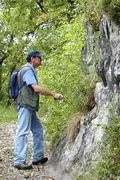 Abstract: The discovery of ammonites of the Aptian - Albian transition (Hypacanthoplites jacobi and Leymeriella tardefurcata biozones) in the Urgonian series from the
sedimentary section exposed in the Arize massif invalidates their former attribution to the lower Clansayesian which was proposed on the basis of
unconstrained paleontological arguments. Abstract: The discovery of ammonites of the Aptian - Albian transition (Hypacanthoplites jacobi and Leymeriella tardefurcata biozones) in the Urgonian series from the
sedimentary section exposed in the Arize massif invalidates their former attribution to the lower Clansayesian which was proposed on the basis of
unconstrained paleontological arguments.
|
|
Online since February 28, 2013
|
|
Memoir
1 [2013]: Revision of the species Hemidiadema rugosum Agassiz,
1846, and H. neocomiense (Cotteau, 1869) (Euechinoidea, Camarodonta, Glyphocyphidae) from the Lower Cretaceous of the Basin of Paris (France), by Arnaud CLÉMENT.-
Format [HTML]
or [PDF
2,725 KB]
Reference: [CG2013_M01]
DOI: 10.4267/2042/48481
Lang.:
|
|
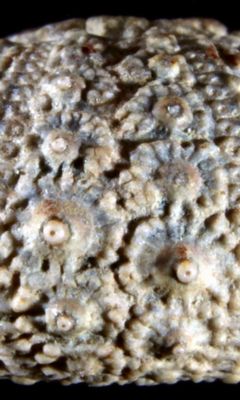 Abstract: Hemidiadema rugosum Agassiz,
1846, and H. neocomiense (Cotteau, 1869) are small and poorly known "regular" echinoid species. They were the
source of much confusion due to their rarity and the inadequacy of their original descriptions. Both species are revised here to clarify their differences and taxonomic status. This revision is based on six specimens of H. rugosum (including the holotype, not shown by its original author), all from the locus typicus and stratum typicum
(Clansayesian [Upper Aptian sensu gallico] "Grès ferrugineux" from Grandpré,
Ardennes) and on a single specimen of H. neocomiense from the stratum typicum (Lower Hauterivian (? Lyticoceras nodosoplicatum Zone) "Calcaire à Spatangues" from Ville-sur-Saulx (Meuse), a locality near to the locus typicus (Auxerre,
Yonne)). For this latter species, a neotype is designated to replace the holotype
that is lost. Remarks on the paleoecology and stratigraphic and geographic distributions of these two species are given. The revision of these two species provides an opportunity to propose an emended diagnosis of the genus Hemidiadema Agassiz,
1846, a poorly known member of the Glyphocyphidae. Abstract: Hemidiadema rugosum Agassiz,
1846, and H. neocomiense (Cotteau, 1869) are small and poorly known "regular" echinoid species. They were the
source of much confusion due to their rarity and the inadequacy of their original descriptions. Both species are revised here to clarify their differences and taxonomic status. This revision is based on six specimens of H. rugosum (including the holotype, not shown by its original author), all from the locus typicus and stratum typicum
(Clansayesian [Upper Aptian sensu gallico] "Grès ferrugineux" from Grandpré,
Ardennes) and on a single specimen of H. neocomiense from the stratum typicum (Lower Hauterivian (? Lyticoceras nodosoplicatum Zone) "Calcaire à Spatangues" from Ville-sur-Saulx (Meuse), a locality near to the locus typicus (Auxerre,
Yonne)). For this latter species, a neotype is designated to replace the holotype
that is lost. Remarks on the paleoecology and stratigraphic and geographic distributions of these two species are given. The revision of these two species provides an opportunity to propose an emended diagnosis of the genus Hemidiadema Agassiz,
1846, a poorly known member of the Glyphocyphidae.
|
|
Online since January 21, 2013
|
|
|
|